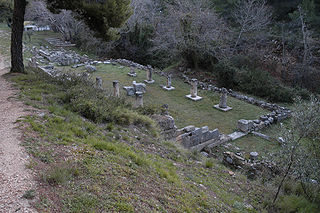
Pergamon, Pergamos or Pergamum, was a rich and powerful ancient Greek city in Aeolis. It is located 26 kilometres (16 mi) from the modern coastline of the Aegean Sea on a promontory on the north side of the river Caicus and northwest of the modern city of Bergama.

The Latin word basilica has three distinct applications in modern English. Originally, the word was used to refer to an ancient Roman public building, where courts were held, as well as serving other official and public functions. It usually had the door at one end and a slightly raised platform and an apse at the other, where the magistrate or other officials were seated. The basilica was centrally located in every Roman town, usually adjacent to the main forum. Subsequently, the basilica was not built near a forum but adjacent to a palace and was known as a "palace basilica".
Kameiros is an ancient city on the island of Rhodes, in the Dodecanese, Greece. It lies on the northwest coast of the island, three km west of the village of Kalavarda.

In classical architecture, a colonnade is a long sequence of columns joined by their entablature, often free-standing, or part of a building. Paired or multiple pairs of columns are normally employed in a colonnade which can be straight or curved. The space enclosed may be covered or open. In St. Peter's Square in Rome, Bernini's great colonnade encloses a vast open elliptical space.

A portico is a porch leading to the entrance of a building, or extended as a colonnade, with a roof structure over a walkway, supported by columns or enclosed by walls. This idea was widely used in ancient Greece and has influenced many cultures, including most Western cultures.

The Ancient Agora of Classical Athens is the best-known example of an ancient Greek agora, located to the northwest of the Acropolis and bounded on the south by the hill of the Areopagus and on the west by the hill known as the Agoraios Kolonos, also called Market Hill. The Agora's initial use was for a commercial, assembly, or residential gathering place.

The Stoa of Attalos was a stoa in the Agora of Athens, Greece. It was built by and named after King Attalos II of Pergamon, who ruled between 159 BC and 138 BC. The current building was reconstructed in 1952–1956 by American architects along with the Greek architect Ioannis Travlos and the Greek Civil Engineer Yeoryios Biris.
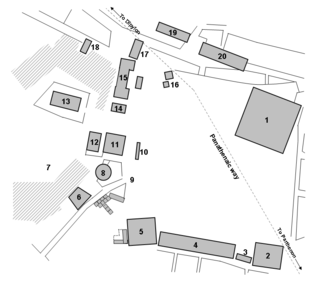
The Stoa Poikile or Painted Porch, originally called the Porch of Peisianax, was erected during the 5th century BC and was located on the north side of the Ancient Agora of Athens. The Stoa Poikile was one of the most famous sites in ancient Athens, owing its fame to the paintings and loot from wars displayed in it. The Stoa was the location from which Zeno of Citium taught Stoicism. The philosophical school of Stoicism takes its name from having first been expounded here, and was derived from the Greek word stoa. Zeno taught and lectured to his followers from this porch. Excavations carried out by the American School of Classical Studies at Athens over the past two decades have revealed much of the foundations and some lower elements of the stoa on the north side of the Athenian Agora; it had a Doric columnar facade and an Ionic interior colonnade.
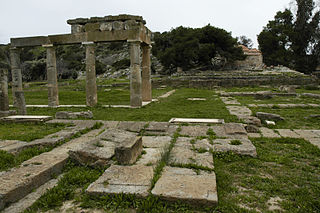
Brauron was one of the twelve cities of ancient Attica, but never mentioned as a deme, though it continued to exist down to the latest times. It was situated on or near the eastern coast of Attica, between Steiria and Halae Araphenides, near the river Erasinus. Brauron is celebrated on account of the worship of Artemis Brauronia, in whose honour a festival was celebrated in this place.
The Stoa of Zeus (Eleutherios) at Athens, was a two-aisled stoa located in the northwest corner of the Ancient Agora of Athens. It was built c. 425 BC–410 BC for religious purposes in dedication to Zeus by the Eleutherios : a cult founded after the Persian War. It is different from others in that it was a stoa rather than a temple. Scholars believe the building also served other civic purposes due to its central location. Researchers think the structure may have been built by Mnesikles, the architect who built the Propylaia. In the late first century BC a two room annex was added, possibly for the cult of the Roman imperial family.
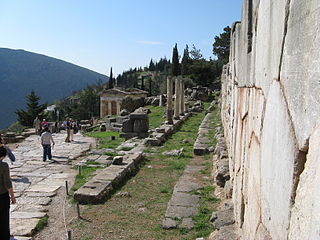
The Stoa of the Athenians is an ancient portico in the Sanctuary of Apollo in Delphi, Greece, located south of the Apollo Temple. The southern side of the polygonal wall of the platform forms the north wall of the stoa. It was constructed c. 478 BC-470 BC during the early Classical period. The one-aisled stoa with Ionic colonnade opens toward the southeast. It was dedicated by the Athenians after the Persian Wars.
The South Stoa I of Athens was located on the south side of the Agora, in Athens, Greece, between the Heliaia and the Enneakrounos, a southeastern fountain house. It was built around 425-400 BC. The stoa was in use until c. 150 BC, when it was replaced by South Stoa II.
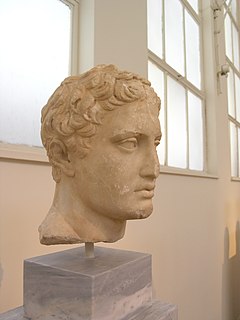
The Stoa of Eumenes is a stoa on the acropolis of Athens, sited between the Odeion of Herodes Atticus and the Theater of Dionysos. It was built against the slope of the hill (meaning it needed a retaining wall supported by piers and round arches. It is named after its builder, Eumenes II of Pergamum. It was two-storied, 46m longer than the Stoa of Attalus and unlike it had no rooms behind its two-aisle hall, meaning it was designed for promenading rather than business. Originally marble-faced, its arcades were built into the 1060 Byzantine defensive wall and are still visible. It had Doric columns externally, Ionic columns on the ground-floor interior and Pergemene-type capitals on the top floor interior. In front of the Stoa are the foundations of the 320BC Monument of Nikias.

The Great Colonnade at Palmyra was the main colonnaded avenue in the ancient city of Palmyra in the Syrian Desert. The colonnade was built in several stages during the second and third century CE and stretched for more than a kilometer. It linked the Temple of Bel, in the southeastern end of the city, to the West Gate and the Funerary Temple in the northwestern part.

The Roman Agora at Athens is located to the north of the Acropolis and to the east of the Ancient Agora.

The Temple of Hera Lacinia, or Juno Lacinia, otherwise known as Temple D, is a Greek temple in the Valle dei Templi, a section of the ancient city of Agrigentum in Sicily.

The Echo Stoa is located within the sanctuary of Zeus in Olympia, Greece. It is part of an ancient archaeological site excavated and preserved by the German Archaeological Institute at Athens. A stoa is a covered walkway or portico, typically colonnaded and open to the public. In ancient Greece a stoa could be used for a variety of reasons including the selling and display of goods, and religious or public meetings. Aside from Delphi, this sanctuary was the most important one in Greece.

